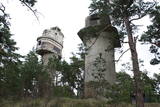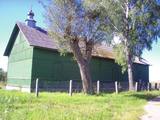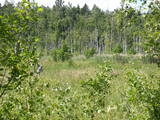| Nr | Name | Beschreibung |
|---|---|---|
|
Am leichtesten kann man diese Batterie finden, wenn man entlang der Meeresküste geht, weil eine von den vier Positionen der Batterie am Strand liegt (abgespült von Meereswellen). Die übrige Positionen, Entfernungsmesser, als auch andere Elementen sind in der Nähe von der Meeresküste – im Kieferwald gelegen. Die Batterie wurde in den vierziger Jahren des vorigen Jahrhunderts aufgestellt. Von diesem Ort kann man die nördischen Befestigungswerke sehen.
|
||
|
Das Café befindet sich im historischen Zentrum von Tukums, am Freiheitsplatz. Lettische Küche: Graupengrütze. |
||
|
Kampišķi Old-Believers Prayer House was reconstructed in 1931
by architect V. Šervinskis. The building is very high and spacious; has two cells and a rectangular belltower with the cross on the top.
|
||
|
This is the thickest and tallest common ivy in Latvia. It is in the park of the Zentene Estate, opposite the mansion (which is now a school).
|
||
|
Diese Schmalspurbahn ist eine schöne Möglichkeit, zurück in die Vergangenheit zu kehren – in die Zeit, wenn auf dem Territorium Lettland eine Epoche der Schmalspurbahnen “herrschte”. Bis zu den 60er Jahren des vorigen Jahrhunderts war die Schmalspurbahn an der Küste von Nordkurland im Einsatz und verband die an der Küste liegenden Fischerdörfer. Bis heutzutage sind die Orte (nur kaum erkennbare Korridore im Hintergrund der Natur), einzelne Stationsgebäude oder die Reste erhalten. Im Freilichtmuseum von Ventspils kann man die 1,4 km lange Ringlinie oder 3 km Berglinie interessant fahren. Am Ende der Berglinie befindet sich eine Drehscheibe. Die Lokomotive der Schmalspurbahn ist 1916 in Deutschland gebaut worden. Man kann auch ein Stationsgebäude mit ganzer Ausrüstung besichtigen. |
||
|
Viens no labākajiem veidiem, kā iepazīties ar sidru, ir paviesoties kādā no sidra darītavām, kur klātienē var redzēt, kā sidrs tiek gatavots. Vairākas sidra darītavas piedāvā apmeklējumus, kuros sidrdari parādīs ražošanas procesu, ļaus nodegustēt savu produkciju un pastāstīs par to. Sidrdari pieņem apmeklētājus pēc iepriekšējas pieteikšanās. Rezervējiet savu apmeklējumu laikus, lai mazajās saimniecībās, kur bieži vien strādā tikai pati ģimene vai pāris darbinieku, sidrdari var paspēt apvienot tūristu uzņemšanu ar savu ikdienas darbu. Parasti sidra darītavas uzņem viesus visu cauru gadu, dažos gadalaikos ir iespējams vērot arī ražošanas procesu, tādēļ sidra darītavas apmeklējumam ieplānojiet apmēram 2 stundas. |
||
|
The ship "Baltā Kaza" transports tourists along the Daugava and also acts as a ferry from Jaunjelgava to Skriveri. In the summer season it runs at regular times. Excursions and trips to the Love Island, Aizkraukle castle ruins, Ķegums HPP, etc. are also possible. Other routes are possible. 25 passenger seats. During the trips you can get acquainted with the narration of cultural-historical, historical and biological objects on both banks of the Daugava. The owner organizes events and concerts both on the Daugava and on the bank of the Daugava. Possibility to rent SUP boards, rowing and canoe boats, catamarans at the berth. |
||
|
Mūsdienās redzamais parks starp Rīgas un Parādes ielu tapa vairāk nekā pirms 100 gadiem un tā patrons bija pilsētas pirmais mērs - Pāvels Dubrovins (1839. – 1890.). Pilsētas „zaļā saliņa”, kuras centrā atrodas strūklaka, ir iecienīta atpūtas un pastaigu vieta. Atraktīvs ir no bronzas veidotais piemineklis (2007. g., tēlnieks A. Tartinovs),kas veltīts pilsētas pirmajam mēram. |
||
|
Eins der prächtigsten Landgutskomplexe Estlands. Das Gutsschloss wurde 1697 gebaut. Das heutige Aussehen hat das Gebäude im 18. Jh. erhalten. Ein Park mit Teichen und Gartenlauben. Viele Wirtschaftsgebäude. |
||
|
Diese Tour kombiniert kulinarische Erlebnisse mit dem Besuch beliebter Touristenziele in Südestland. Sie besuchen Võru und Rõuge, lassen sich von der südestnischen Landschaft im Haanja-Naturpark verzaubern und schauen vom Aussichtsturm auf Estlands höchster Erhebung – dem Suur Munamägi („Großer Eierberg“) – in die Ferne und nach Setomaa, das „Land der Setus“. Dorthin fahren Sie danach und werden herzlich willkommen geheißen von einer kleinen ethnischen Volksgruppe, die ihre einzigartigen Traditionen und ihre Sprache bis heute lebendig hält. Menschen leben seit etwa 8.400 Jahren in Setomaa. Auf der Rundtour verkosten Sie estnische Weine aus Beeren und Früchten, besuchen eine Ziegenfarm, die erstklassigen Käse herstellt und verspeisen ein herzhaftes Bauerngericht auf einem ländlichen Gehöft. Die Route beginnt und endet in Tartu, kann aber auch in Tallinn oder Riga begonnen oder beendet werden. |
||
|
In the workshop it is possible to learn about the process of creating and the usage of pottery of different historic periods, as well as other household goods. Archaeological pottery is presented. The Middle Ages man-carried clay bread oven, frying-pan, drinking cups, the pilgrims’ water bowls. All the works are handmade in the moulded ceramics style and burned in the clay kiln. |
||
|
Dieses morastige Gebiet war Teil der Litorina - Meereslagune und ist ein Gebiet, wo es viele seltene und geschützte Vögel gibt, z.B. leben und nisten hier Spechte. Ein Teil des Territoriums kann von der Straße Tukums-Kolka aus überblickt werden.
|
||
|
Antons Rancans produces wooden busts of well known people from politics, the arts and other fields of endeavour, and these can be purchased. Visitors can also commission decorative objects that are produced from wood. The artist also produces crucifixes. Gundega Rancāne is a landscape painter who is renowned for her masterful use of light and shadow. Her works are available for purchase.
|
||
|
Es wurden sechs Standpunkte mit Informationsständen gestaltet, auf denen der See, der Wald, die Wiese, die Dünen und das Moor (Aussichtsturm) vorgestellt und die Prozesse in der Natur dargestellt werden.
|
||
|
Ceļa malā, kas ved uz Kärdla pilsētu, ir zivju pārstrādes veikals, kur iespējams iegādāties Hījumā zvejnieku nozvejotas zivis gan svaigas, gan kūpinātas, kā arī tiek pārdoti Hījumā mazo ražotāju produkti. Zivis iespējams nobaudīt arī turpat uz vietas, veikalā ir kafejnīcas stūrītis, bet vasarā ārpusē ir terase.
|
||
|
Gelegen am linken Ufer des Emajõgi Flusses, am Fuß des Dombergs. Der Mittelpunkt der Altstadt ist der im Stil des Klassizismus gebaute Rathausplatz mit dem Rathaus und dem Springbrunnen „Die küssenden Studenten“, der ein Stadtsimbol ist. |
||
|
Eins der bewaldeten und seenartigen (ung. 285 Seen) Gebiete Litauens mit vielfältigen Erholungsmöglichkeiten, einbezogen aktive Erholung. |
||
|
Diese Route führt Sie in die Region Kurzeme, wo Sie traditionelle Speisen der Region kennenlernen. Die Tour beginnt in Riga und bringt Sie in einige der schönsten Naturregionen, in denen Sie wandern können, was wiederum den Appetit anregen wird. Auf dem Dieniņas-Fischerhof können Sie Räucherfisch essen, in Kolka an einem Workshop im Backen von „Sklandrausis“ (eine traditionelle Möhrenpirogge) teilnehmen, im Nationalpark Slītere Fischerdörfer besuchen und in den Gaststätten von Ventspils raffiniert zubereitete Gerichte genießen. Schöne Attraktionen auf dem Weg sind die Ostseesteilküste bei Jūrkalne und das mittelalterliche Städtchen Kuldīga. In einer Wassermühle aus dem 19. Jahrhundert, die heute ein Bio-Bauernhof ist, gibt die Gastgeberin einen Kochkurs in lokaler Küche mit Gerichten aus Damwild, Forelle, Gemüse und Obst. Die letzte Station vor der Rückkehr nach Riga ist das Schokoladenmuseum in Pūre. |
||
|
Der deutsche Pastor Glück vollendete während seiner Amtszeit in Alūksnē eines der bedeutendsten Werke seine Lebens – er fertigte die erste lettische Bibelübersetzung an. 1685 hatte er das Neue Testament, 1689 das Alte Testament übersetzt und jeweils zum Gedenken an die vollendete Arbeit eine Eiche gepflanzt, beide wachsen dort heute noch. |
||
|
Iespēja patīkamā atmosfērā baudīt ļoti gardu ēdienu. . Starp tiem arī Lietuviešu tradicionālo ēdienu. Ir dienas un vakara īpašie piedāvājumi. |
||
























